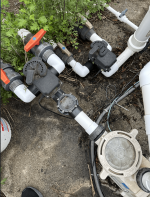pepper,
Since we now know that you have two skimmers on one pipe.. this means that the skimmer nearest to the equipment pad will get a lot of suction and the far skimmer will get very little suction.. And, I think that is what you reported already.
I find it odd that your intake valve is set so that it can't close off the Spa side of the plumbing..

But your return valve does..
When you get around to it, here is a test I'd like you to do..
1. Use the little toggle on the valve actuators and set both automatic valves back to the original middle position.. This would mean that both the Spa and Pool pipes would be fully open.
2. Close the manual orange/black ball valves on both Spa pipes. This would mean you would suck all the water from the pool and return the water to just the pool.
3. Things to look for:
a. How well does the pump work?
b. How well does the near skimmer work?
c. How well does the far skimmer work?
d. How well do your wall returns work and how many wall returns do you have?
e. Does this configuration have any impact on the spa? ( I would think not..)
4. Leave all the valves as set above, but ... Open the black manual ball valve for the Spa Return about 1/4 of the way.
a. Does the water level in the spa increase over time?
b. If so, shut the spa pipe off, before it goes over the coping.
c. If not, where does the water go..?
5. Open the manual Spa ball valves and close the manual Pool ball valves. This means all the water is coming from the spa and returning to the spa. This is how you would heat the spa..
a. How well does the pump work.
b. Are the skimmer shut off?
c. Are your spa jets working?
d. Is water level in the spa stable or is it going up or down?
Obviously, you don't have to do any of this..

I just think it would be nice to know how well the pool works in just the Pool mode, and then just the spa mode, and in the normal "spillover" mode. The spillover mode is the one that bothers me.. It is almost impossible to to adjust the valves so that the exact amount of water that comes out of the spa, is going into the spa.. This means that the over time the water in the spa will increase and overflow the coping, or it will decrease and the spa will run out of water.
Thanks,
Jim R.




 But your return valve does..
But your return valve does..